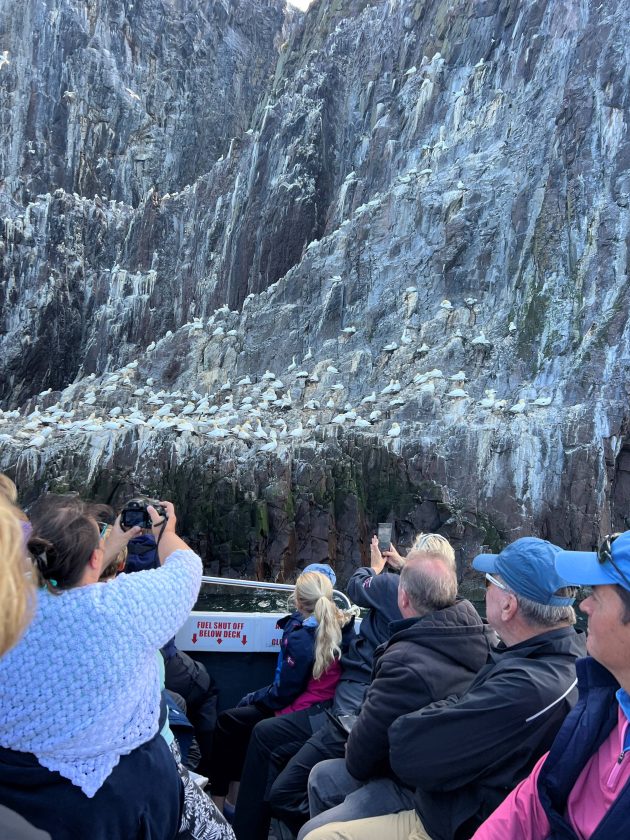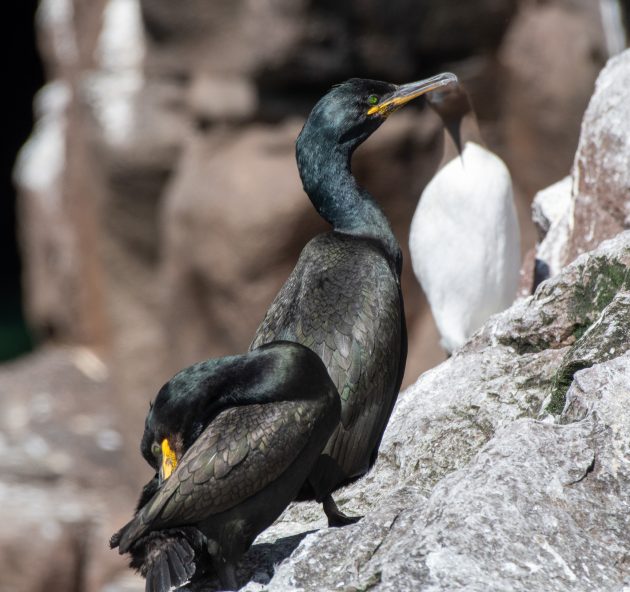
Global BirdFair is an extraordinary sight that, up until 2022, we had only heard tales of. So, Erik and I decided we would have to see it for ourselves. The first time we experienced it, we flew into Leicester and took the short drive over. Then, when we chose to go back in 2023 to see if there was a difference between the two years, we planned to fly in and out of Edinburgh so that we could explore a new place. When we mentioned this on our podcast, several emails came in from listeners directing us to look into a visit to Bass Rock. When I finally got around to investigating Bass Rock the week before our trip, I realized why it was at the top of the lists.
Bass Rock, an island nestled in the Firth of Forth, is a testament to nature’s grandeur and history’s resilience. Situated on the eastern side of Scotland, approximately three miles northeast of North Berwick, it is the closest village from which boat trips embark. The rock, reaching a height of 350 feet at its peak, is a ‘volcanic plug,’ a solidified remnant of a volcano’s plumbing system that endures long after the volcano has eroded away. The island’s history is as captivating as its geology, having served as a sanctuary, a castle, a prison, and a lighthouse. It was last acquired in 1706 by Hew Hamilton-Dalrymple. Its allure has captivated and inspired generations. A visit to Bass Rock unveils the Bass Rock Lighthouse built in 1902, the remnants of an ancient chapel, and a symphony of squawking birds.
Birders flock to this haven, as it is a sanctuary for over 150,000 breeding Northern Gannets, making it the world’s largest colony. Interestingly, the Latin binomial for Northern Gannet is Morus bassanus, a name derived from their association with the rock. The island is teeming with so many birds that their eggs and young chicks were once harvested for food. The Scottish Seabird Centre offers daily expeditions to Bass Rock, each with its own unique itinerary. We had the foresight to book the Three Islands Seabird Seafari in advance, a thrilling journey where we would see the seabirds around Lamb, Craigleith, and Bass Rock from a small inflatable boat. But unfortunately, we overslept our alarms, which I blame on jetlag. Despite a nerve-wracking drive from Edinburgh, we arrived to see the boat pulling out of the harbor with our two seats empty. So, we went into the office and were able to arrange the Seabird Catamaran Cruise for the following day. Thus, we embarked on a highland adventure, spotting a Ring Ouzel, before immersing ourselves in the bustling streets of downtown Edinburgh.

The next day, we set extra alarm clocks and made it with plenty of time to spare. The marina is quaint, with a discovery center and a few shops. When we arrived, participants were lined up to board the Seafari Explorer. It was a beautiful day to be out on the water, and in no time, we were cruising around Craigleith with Atlantic Puffins, Razorbills, Common Murres, and Black-legged Kittiwakes. All are at eye level, as the island is less than 150 feet high. The birds on this island face their own challenges with Tree Mallow, a non-native plant that has endangered the puffin colony. The Scottish Seabird Centre supports hundreds of volunteers in the effort to eradicate this species when it was first noticed that the number of puffins was declining.


Our captain then directed the boat towards the real showstopper: Bass Rock. The beehive of Northern Gannets came into view, and towering cliffs became more defined. Thousands of Northern Gannets were swirling around in the skies above our catamaran, clearly showing why Sir David Attenborough declared it “one of the wildlife wonders of the world.” The steep walls were dotted with nesting birds and downy chicks about ready to fledge.


While researching this trip, there was a common theme in the articles relating to the gannets: Avian Flu hit this colony hard in 2022. On a single day, more than 5,000 dead birds were counted. Gannets breed after their fourth year, so it will take years to recover from the devastation this disease caused. An odd side effect was noticed by researchers – black irises. Gannets typically have pale blue eyes, and those with black irises have avian flu antibodies. The iris difference was evident in close individuals and, hopefully, a sign that the colony will persist in this disease.

We spent about a half-hour circumnavigating the rock and added European Shag, a few puffins, and two Great Black-backed Gulls. The acrid smell of the seabirds’ guano filled the air as we toured along the steep cliffs. A few unlucky (or lucky) participants had to wipe drops off their shoulders. I enjoyed a close look at the historic lighthouse and the decrepit chapel, a reminder that our visit is a brief moment in humankind’s long history with this place.


We motored away from the island towards the mainland, and the busy gannets became smaller and smaller. The white top of the rock came into view, painted with the droppings of millennia of feathered residents. I hardly remember the trip back as my head was swirling with visions of gannets flying high in the breeze. After a quick bite to eat at a spot up the road from the marina, we jumped in the car and headed to Global BirdFair.
Something I love about birding is the readily available sharing of information. I can mention somewhere we are going on our podcast or online, and someone will quickly share their experiences. Hopefully, I can keep it going and might have helped you on a future trip. This was definitely a trip to remember, and we have others to thank for mentioning it.
Here more about this adventure on Hannah and Erik Go Birding.













Leave a Comment